Nature-Based Solutions for Cooling in High-Density Neighbourhoods in Shenzhen: A Case Study of Baishizhou
Abstract
:1. Introduction
2. Materials and Methods
2.1. Case Study
2.2. Method Review
2.3. Method Workflow
2.4. Scenario Design
2.5. Modelling of the Original Area and Designed Area
- Setting the initial environmental parameters: environmental parameters were obtained from the Visual Crossing website (Figure 4). To address the adverse effects of excessive heat during the summer, particularly in densely populated urban areas, the study day was set to 9 August 2019, the hottest day of the year. To ensure data stability, the simulation period was set from 01:00 a.m. to 24:00 p.m. on the case study day, for a duration of 24 h. Based on the actual site size, the X, Y, and Z axes of the model were set at 85, 85, and 44 grids with a two-meter resolution, respectively. A mesh size of 2 × 2 × 2 was set to provide a sufficient resolution for the analysis within a reasonable timeframe, given the computing resources and the required level of detail [43]. To reduce the influence of boundaries, the Z-axis height within the simulation range was set to be more than twice as high as the top-height building within the simulation range [43]. Consequently, 44 grids were set along the Z-axis. The detailed simulation parameters are shown in Table 2.
2.6. Outdoor Thermal Comfort Indices
2.7. Building Surface Temperature
3. Results
3.1. Thermal Comfort Results
3.2. Exterior Building Surface Temperature
4. Discussion
4.1. NBS for the High-Density Neighbouthood
4.2. Scenario Simulation Method for the Case Study
4.3. Adding Trees Have the Greatest Positive Impacts on Outdoor Thermal Comfort
4.4. Introduced Facade and Roof Greening into the High-Density Area to Alleviate the Building Surface Temperature
5. Limitations
6. Conclusions
Author Contributions
Funding
Institutional Review Board Statement
Informed Consent Statement
Data Availability Statement
Conflicts of Interest
References
- Lai, Y.; Ning, Q.; Ge, X.; Fan, S. Thermal regulation of coastal urban forest based on Envi-Met Model—A case study in Qinhuangdao, China. Sustainability 2022, 14, 7337. [Google Scholar] [CrossRef]
- Liu, B.; Lian, Z.; Brown, R.D. Effect of landscape microclimates on thermal comfort and physiological wellbeing. Sustainability 2019, 11, 5387. [Google Scholar] [CrossRef] [Green Version]
- Huang, H.; Deng, X.; Yang, H.; Li, S. Spatial evolution of the effects of urban heat island on residents’ health. Teh. Tech. Gaz. 2020, 27, 1427–1435. [Google Scholar] [CrossRef]
- European Commission. Nature-Based Solutions & Re-Naturing Cities; European Commission: Brussel, Belgium, 2015; p. 74. [Google Scholar]
- Sowińska-Świerkosz, B.; García, J. What are nature-based solutions (NBS)? setting core ideas for concept clarification. Nat.-Based Solut. 2022, 2, 100009. [Google Scholar] [CrossRef]
- Zingraff-Hamed, A.; Hüesker, F.; Lupp, G.; Begg, C.; Huang, J.; Oen, A.; Vojinovic, Z.; Kuhlicke, C.; Pauleit, S. Stakeholder mapping to co-create nature-based solutions: Who is on board? Sustainability 2020, 12, 8625. [Google Scholar] [CrossRef]
- Wickenberg, B.; McCormick, K.; Olsson, J.A. Advancing the implementation of nature-based solutions in cities: A review of Frameworks. Environ. Sci. Policy 2021, 125, 44–53. [Google Scholar] [CrossRef]
- Roggema, R.; Tillie, N.; Keeffe, G. Nature-based urbanization: Scan Opportunities, determine directions and create inspiring ecologies. Land 2021, 10, 651. [Google Scholar] [CrossRef]
- Dorst, H.; van der Jagt, A.; Raven, R.; Runhaar, H. Urban greening through nature-based solutions—Key characteristics of an emerging concept. Sustain. Cities Soc. 2019, 49, 101620. [Google Scholar] [CrossRef]
- Kabisch, N.; Korn, H.; Stadler, J.; Bonn, A. Nature-based solutions to climate change adaptation in urban areas—Linkages between science, policy and practice. In Nature-Based Solutions to Climate Change Adaptation in Urban Areas; Theory and Practice of Urban Sustainability Transitions Book Series (TPUST); Springer: Cham, Switzerland, 2017; pp. 1–11. [Google Scholar] [CrossRef] [Green Version]
- Roggema, R. From nature-based to nature-driven: Landscape first for the design of Moeder Zernike in Groningen. Sustainability 2021, 13, 2368. [Google Scholar] [CrossRef]
- European Commission. Nature-Based Solutions Generate Greener Urban Renewal. Available online: https://ec.europa.eu/research-and-innovation/en/horizon-magazine/nature-based-solutions-generate-greener-urban-renewal (accessed on 27 December 2022).
- Balany, F.; Ng, A.W.M.; Muttil, N.; Muthukumaran, S.; Wong, M.S. Green Infrastructure as an urban heat island mitigation strategy—A Review. Water 2020, 12, 3577. [Google Scholar] [CrossRef]
- Sung, C.Y. Mitigating surface urban heat island by a tree protection policy: A case study of the woodland, Texas, USA. Urban For. Urban Green. 2013, 12, 474–480. [Google Scholar] [CrossRef]
- Wang, Y.; Akbari, H. The effects of street tree planting on urban heat island mitigation in Montreal. Sustain. Cities Soc. 2016, 27, 122–128. [Google Scholar] [CrossRef]
- Hayes, A.T.; Jandaghian, Z.; Lacasse, M.A.; Gaur, A.; Lu, H.; Laouadi, A.; Ge, H.; Wang, L. Nature-based solutions (nbss) to mitigate urban heat island (UHI) effects in Canadian cities. Buildings 2022, 12, 925. [Google Scholar] [CrossRef]
- Amani-Beni, M.; Zhang, B.; Xie, G.-D.; Odgaard, A.J. Impacts of the microclimate of a large urban park on its surrounding built environment in the Summertime. Remote Sens. 2021, 13, 4703. [Google Scholar] [CrossRef]
- Kim, Y.; An, S.; Eum, J.-H.; Woo, J.-H. Analysis of thermal environment over a small-scale landscape in a densely built-up Asian megacity. Sustainability 2016, 8, 358. [Google Scholar] [CrossRef] [Green Version]
- Andric, I.; Kamal, A.; Al-Ghamdi, S.G. Efficiency of green roofs and green walls as climate change mitigation measures in extremely hot and dry climate: Case study of Qatar. Energy Rep. 2020, 6, 2476–2489. [Google Scholar] [CrossRef]
- Bush, J.; Doyon, A. Building urban resilience with nature-based solutions: How can urban planning contribute? Cities 2019, 95, 102483. [Google Scholar] [CrossRef]
- Wu, Y.; Zhang, Y. Formal and informal planning-dominated Urban Village Development: A Comparative Study of Luojiazhuang and Yangjiapailou in Hangzhou, China. Land 2022, 11, 546. [Google Scholar] [CrossRef]
- Hao, P.; Sliuzas, R.; Geertman, S. The development and redevelopment of urban villages in Shenzhen. Habitat Int. 2011, 35, 214–224. [Google Scholar] [CrossRef]
- Hao, P.; Geertman, S.; Hooimeijer, P.; Sliuzas, R. Spatial evolution of urban villages in Shenzhen. In Rural Migrants in Urban China; Routledge: Oxfordshire, UK, 2013; pp. 202–220. [Google Scholar] [CrossRef]
- Tan, X.; Altrock, U.; Schoon, S.; Zhao, J. Localized place-making and the knowledge-based regeneration strategies—The case of Xiasha village in Shenzhen. Habitat Int. 2019, 83, 73–84. [Google Scholar] [CrossRef]
- Chan, K.W.; Zhang, L. The hukou system and rural-urban migration in China: Processes and changes. China Q. 1999, 160, 818–855. [Google Scholar] [CrossRef] [Green Version]
- Wang, Y.P.; Wang, Y.; Wu, J. Urbanization and informal development in China: Urban villages in Shenzhen. Int. J. Urban Reg. Res. 2009, 33, 957–973. [Google Scholar] [CrossRef]
- Zheng, Y.; Keeffe, G. Defining ecological niches for green facades: A case study in Shenzhen, China. In Ecocity World Summit 2021–22: Conference Proceedings; Ecocity Builders: Oakland, CA, USA, 2022; pp. 133–141. [Google Scholar]
- Rodriguez-Valencia, A.; Ortiz-Ramirez, H.A. Understanding green street design: Evidence from three cases in the U.S. Sustainability 2021, 13, 1916. [Google Scholar] [CrossRef]
- Morakinyo, T.E.; Lai, A.; Lau, K.K.-L.; Ng, E. Thermal benefits of vertical greening in a high-density city: Case study of Hong Kong. Urban For. Urban Green. 2019, 37, 42–55. [Google Scholar] [CrossRef]
- Safikhani, T.; Abdullah, A.M.; Ossen, D.R.; Baharvand, M. A review of energy characteristic of vertical greenery systems. Renew. Sustain. Energy Rev. 2014, 40, 450–462. [Google Scholar] [CrossRef]
- Köhler, M. Green facades—A view back and some visions. Urban Ecosyst. 2008, 11, 423–436. [Google Scholar] [CrossRef]
- Besir, A.B.; Cuce, E. Green roofs and facades: A comprehensive review. Renew. Sustain. Energy Rev. 2018, 82, 915–939. [Google Scholar] [CrossRef]
- Shenzhen Bureau of Statistics. Data of the Seventh National Census of Shenzhen in 2020; Shenzhen Bureau of Statistics: Shenzhen, China, 2020. [Google Scholar]
- Shenzhen Climate Bulletin 2019. Available online: http://weather.sz.gov.cn/attachment/0/951/951411/6851743.pdf (accessed on 21 December 2022).
- Bruse, M.; Fleer, H. Simulating surface–plant–air interactions inside urban environments with a three dimensional numerical model. Environ. Model. Softw. 1998, 13, 373–384. [Google Scholar] [CrossRef]
- Srivanit, M.; Hokao, K. Evaluating the cooling effects of greening for improving the Outdoor Thermal Environment at an institutional campus in the Summer. Build. Environ. 2013, 66, 158–172. [Google Scholar] [CrossRef]
- ENVI-Met. Available online: https://www.envi-met.com/ (accessed on 21 December 2022).
- Fang, X.; Shen, L.; Meng, Q. The study on microclimate simulation of Country Park based on Envi-met software—Take the East Gate entrance area of Guangdong Tianlu lake country park for example. In Proceedings of the 3rd International Conference on Mechatronics, Robotics and Automation; Advances in Computer Science Research Series; Atlantis Press: Amsterdam, The Netherlands, 2015. [Google Scholar] [CrossRef] [Green Version]
- Yang, J.; Hu, X.; Feng, H.; Marvin, S. Verifying an Envi-Met Simulation of the Thermal Environment of Yanzhong Square Park in Shanghai. Urban For. Urban Green. 2021, 66, 127384. [Google Scholar] [CrossRef]
- Rhinoceros. Available online: Rhino3d.com (accessed on 15 March 2023).
- Grasshopper 3D. Available online: grasshopper3d.com (accessed on 15 March 2023).
- Ladybug Tools. Available online: https://www.ladybug.tools/dragonfly.html (accessed on 15 February 2023).
- Teshnehdel, S.; Gatto, E.; Li, D.; Brown, R.D. Improving outdoor thermal comfort in a steppe climate: Effect of water and trees in an urban park. Land 2022, 11, 431. [Google Scholar] [CrossRef]
- ASHRAE. Thermal Environmental Conditions for Human Occupancy; ASHRAE: Atlanta, GA, USA, 2010. [Google Scholar]
- Höppe, P. Different aspects of assessing indoor and outdoor thermal comfort. Energy Build. 2002, 34, 661–665. [Google Scholar] [CrossRef]
- Coccolo, S.; Pearlmutter, D.; Kaempf, J.; Scartezzini, J.-L. Thermal Comfort Maps to Estimate the Impact of Urban Greening on the Outdoor Human Comfort. Urban For. Urban Green. 2018, 35, 91–105. [Google Scholar] [CrossRef]
- Shooshtarian, S.; Lam, C.K.; Kenawy, I. Outdoor Thermal Comfort Assessment: A Review on Thermal Comfort Research in Australia. Build. Environ. 2020, 177, 106917. [Google Scholar] [CrossRef]
- Lai, D.; Guo, D.; Hou, Y.; Lin, C.; Chen, Q. Studies of Outdoor Thermal Comfort in Northern China. Build. Environ. 2014, 77, 110–118. [Google Scholar] [CrossRef]
- Laouadi, A. A New General Formulation for the PMV Thermal Comfort Index. Buildings 2022, 12, 1572. [Google Scholar] [CrossRef]
- Gatto, E.; Buccolieri, R.; Aarrevaara, E.; Ippolito, F.; Emmanuel, R.; Perronace, L.; Santiago, J.L. Impact of Urban Vegetation on Outdoor Thermal Comfort: Comparison between a Mediterranean City (Lecce, Italy) and a Northern European City (Lahti, Finland). Forests 2020, 11, 228. [Google Scholar] [CrossRef] [Green Version]
- Elnabawi, M.H.; Hamza, N. Behavioural Perspectives of Outdoor Thermal Comfort in Urban Areas: A Critical Review. Atmosphere 2019, 11, 51. [Google Scholar] [CrossRef] [Green Version]
- Taib, N. Assessment of Physiological Equivalent Temperature (PET) in Transitional Spaces of a High-Rise Building. Asian J. Behav. Stud. 2018, 3, 13–21. [Google Scholar] [CrossRef]
- Zare, S.; Hasheminejad, N.; Shirvan, H.E.; Hemmatjo, R.; Sarebanzadeh, K.; Ahmadi, S. Comparing Universal Thermal Climate Index (UTCI) with Selected Thermal Indices/Environmental Parameters during 12 Months of the Year. Weather. Clim. Extrem. 2018, 19, 49–57. [Google Scholar] [CrossRef]
- UTCI. Available online: https://envi-met.info/doku.php?id=apps:biomet_utci (accessed on 4 January 2023).
- Höppe, P. The physiological equivalent temperature—A universal index for the biometeorological assessment of the thermal environment. Int. J. Biometeorol. 1999, 43, 71–75. [Google Scholar] [CrossRef] [PubMed]
- Matzarakis, A.; Mayer, H. Another Kind of Environmental Stress: Thermal Stress. WHO Colloborating Centre for Air Quality Management and Air Pollution Control. Newsletters 1996, 18, 7–10. [Google Scholar]
- Tsoka, S.; Tsikaloudaki, K.; Theodosiou, T. Urban Space’s Morphology and Microclimatic Analysis: A Study for a Typical Urban District in the Mediterranean City of Thessaloniki, Greece. Energy Build. 2017, 156, 96–108. [Google Scholar] [CrossRef]
- Charisi, S.; Thiis, T.K.; Stefansson, P.; Burud, I. Prediction Model of Microclimatic Surface Conditions on Building Façades. Build. Environ. 2018, 128, 46–54. [Google Scholar] [CrossRef]
- Slávik, R.; Čekon, M. Study of Surface Temperature Monitoring in the Field of Buildings. Procedia Eng. 2016, 161, 1135–1143. [Google Scholar] [CrossRef] [Green Version]
- Forouzandeh, A. Prediction of Surface Temperature of Building Surrounding Envelopes Using Holistic Microclimate Envi-Met Model. Sustain. Cities Soc. 2021, 70, 102878. [Google Scholar] [CrossRef]
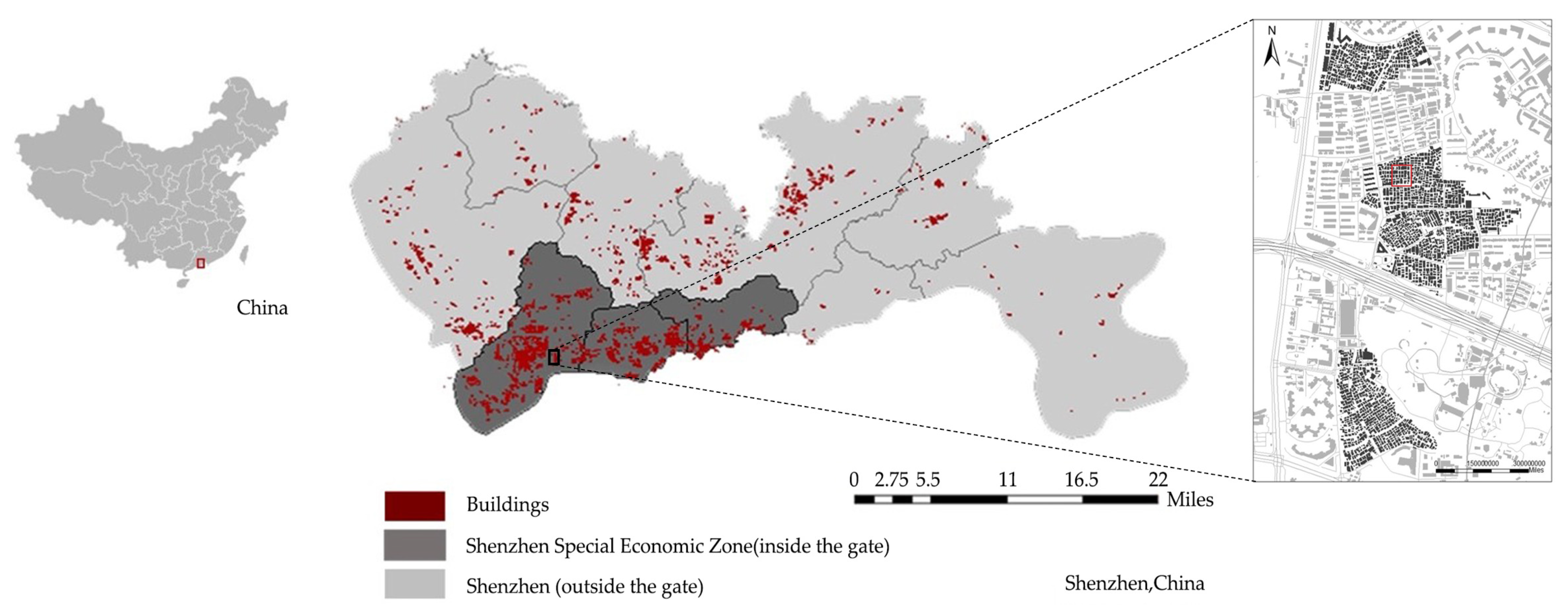
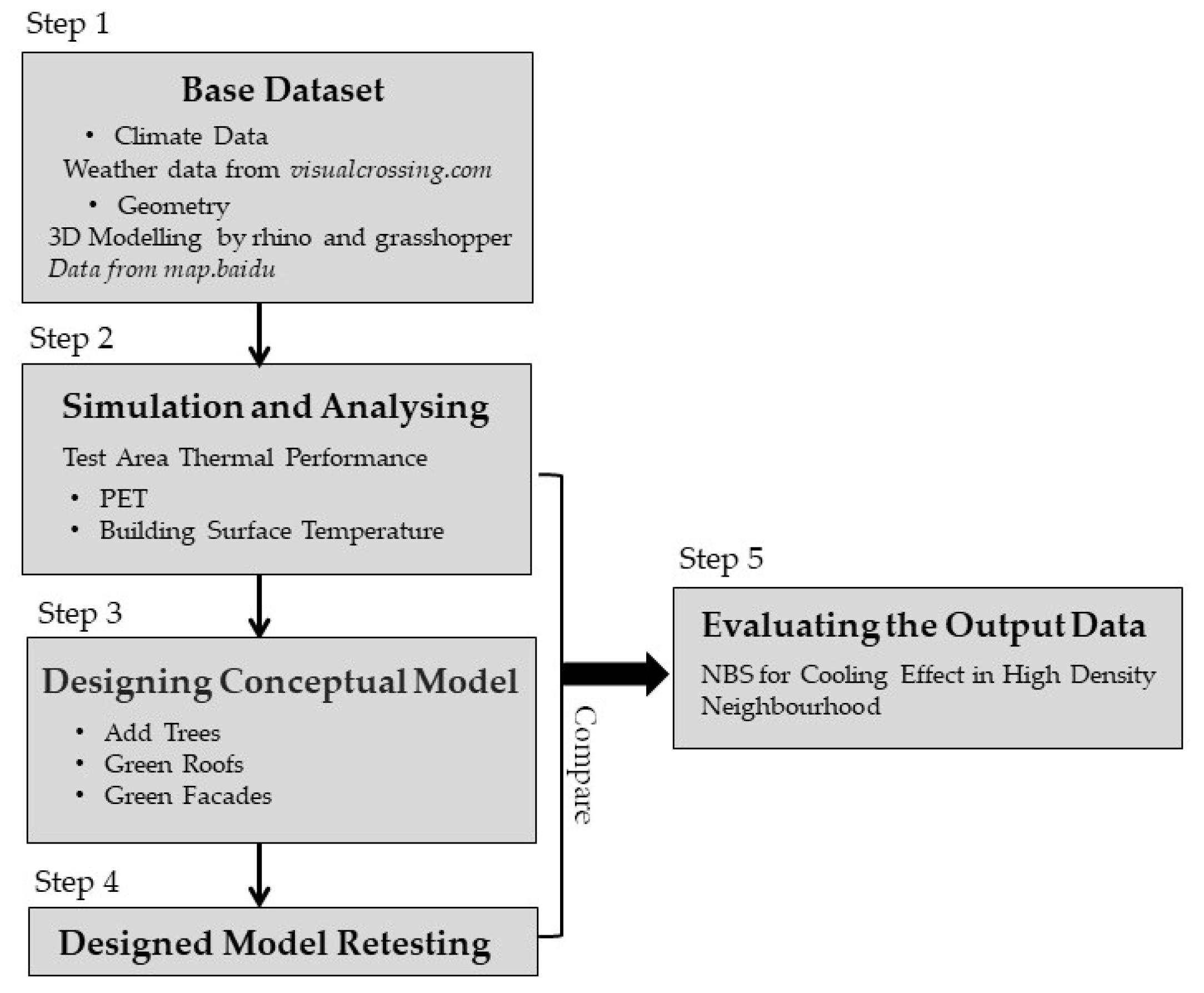




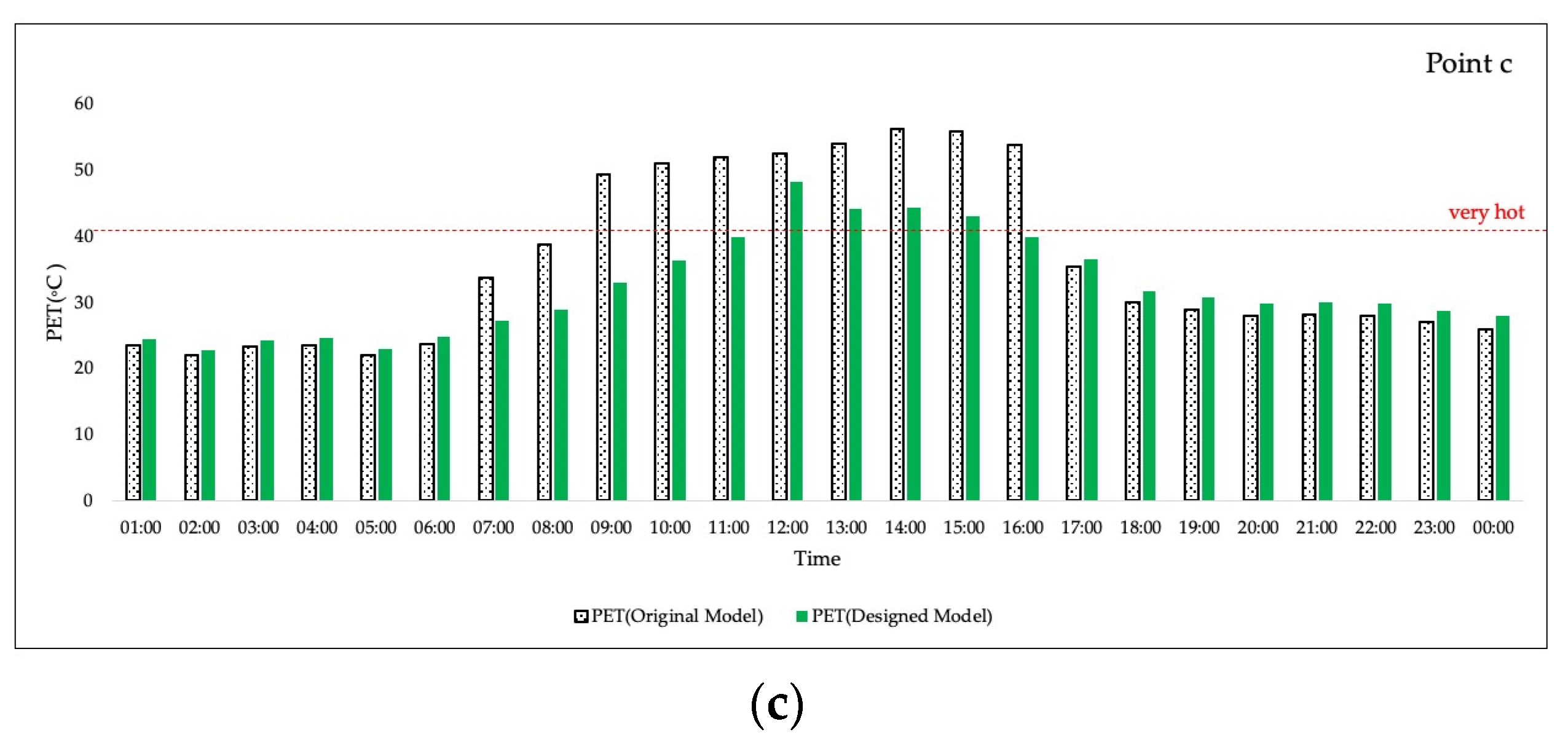

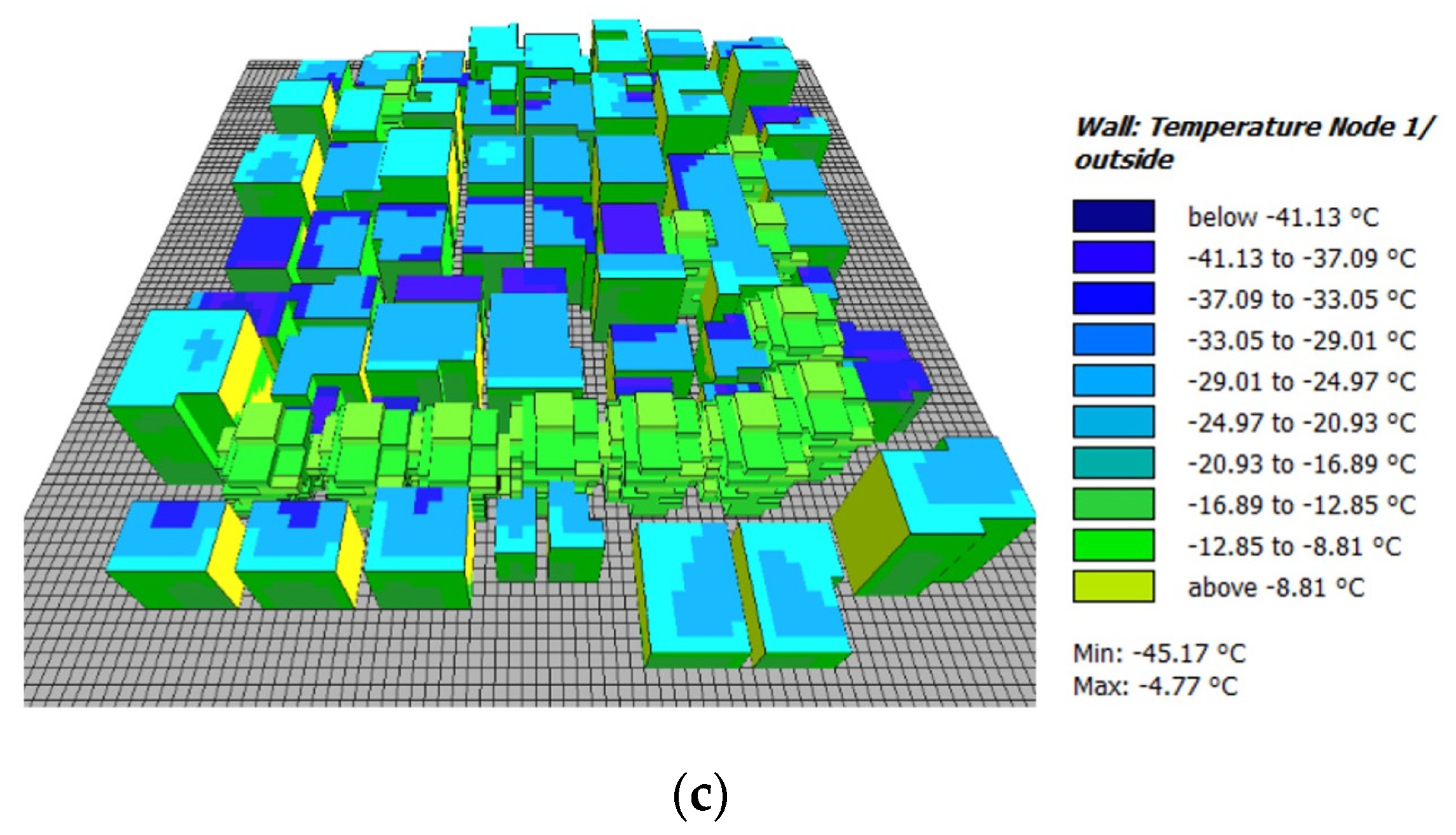
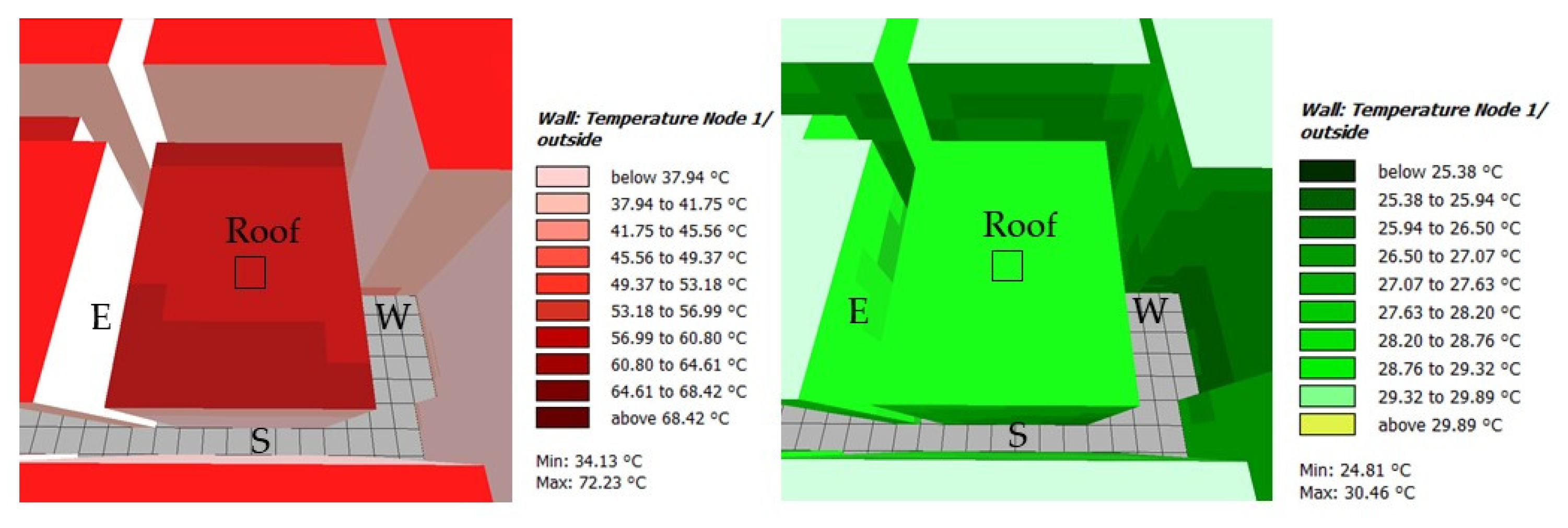


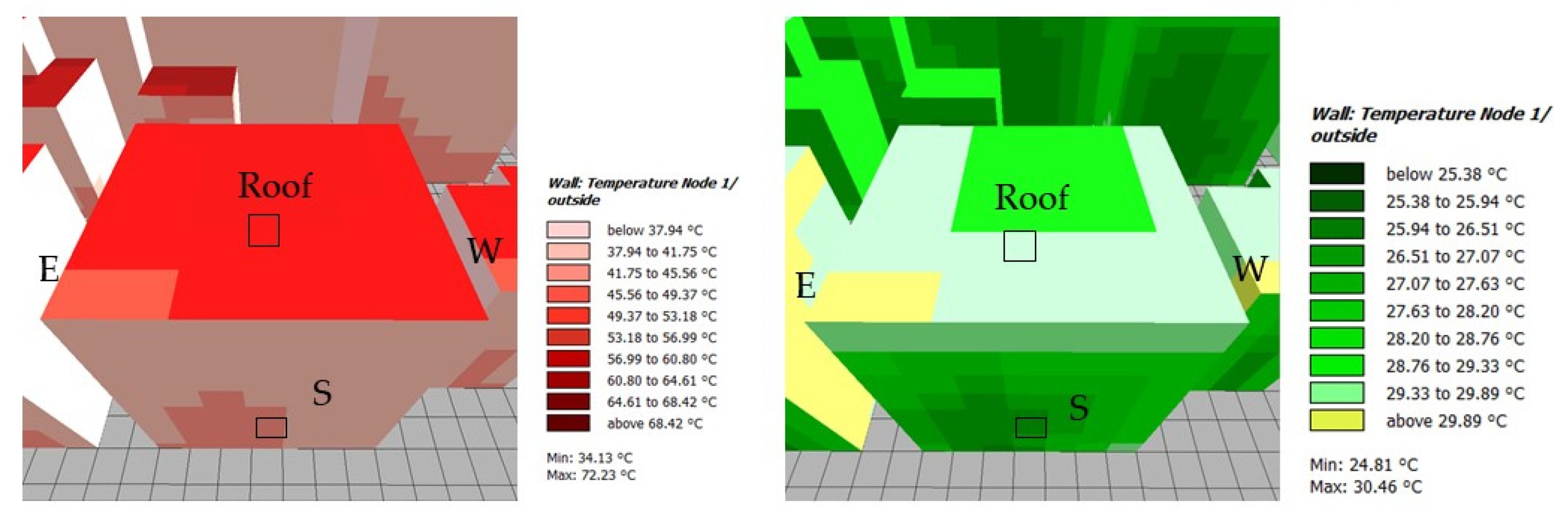
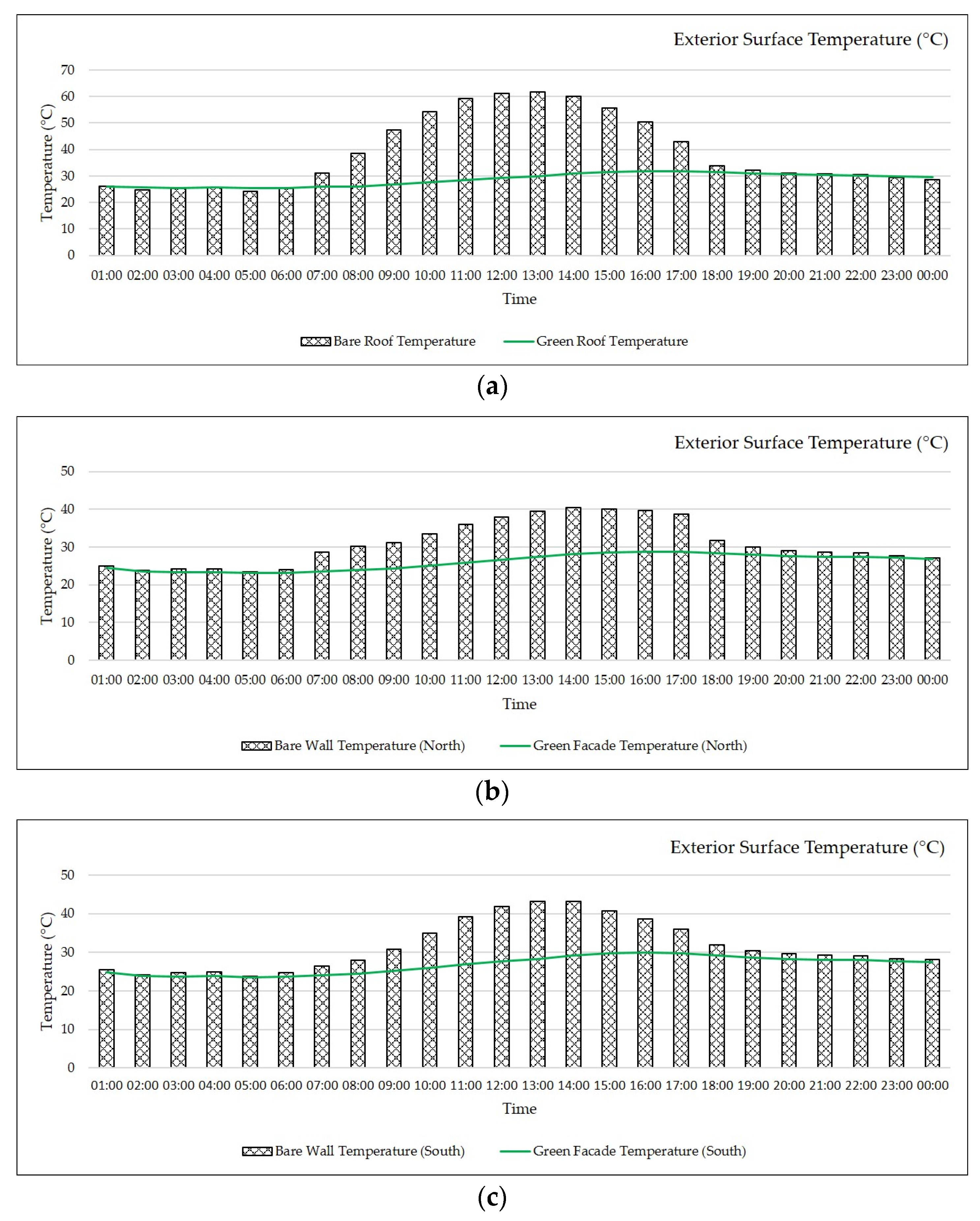
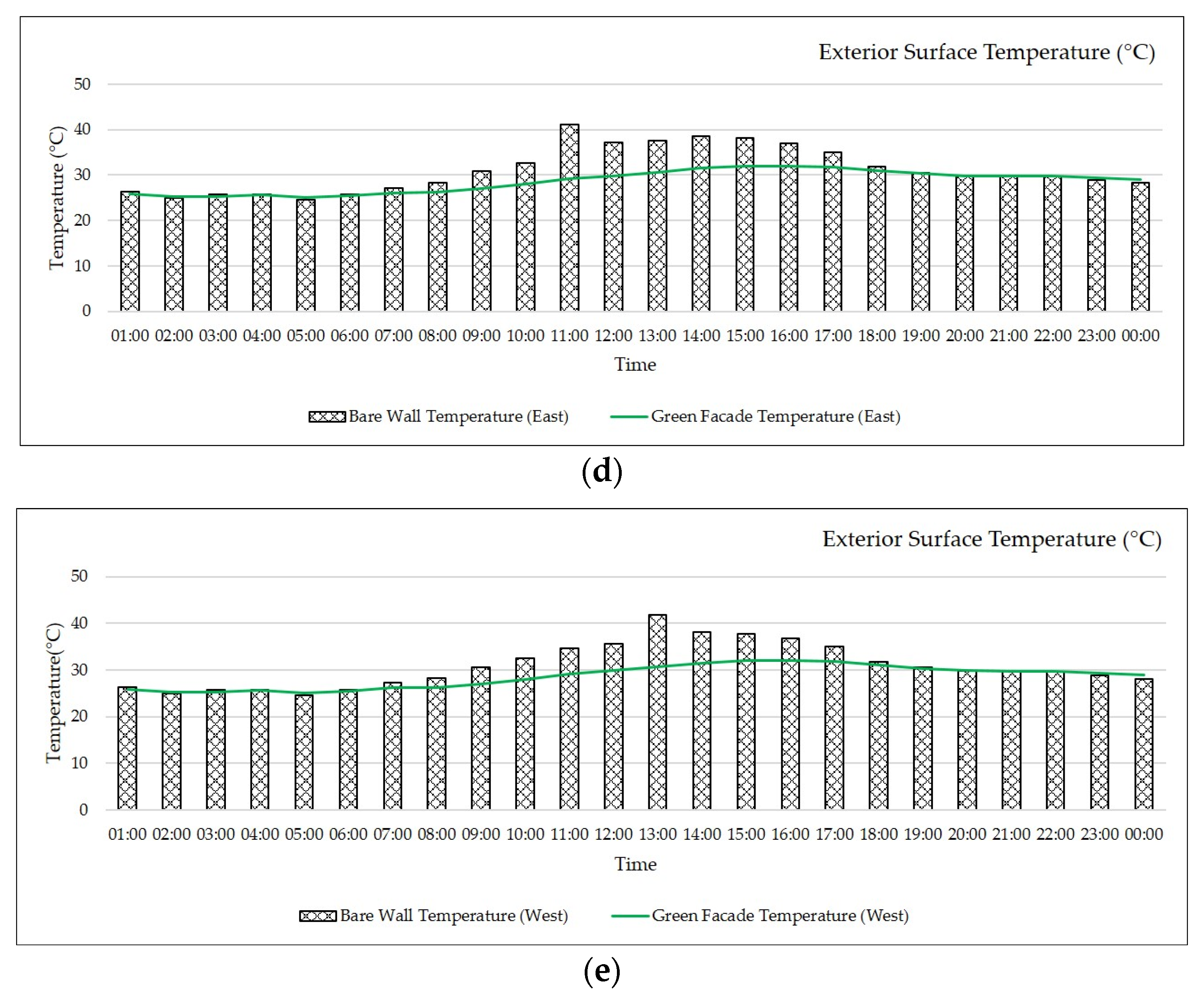
| Classification | Existing Material | Improved Material | ||
|---|---|---|---|---|
| Pavements | Concrete | 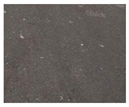 | Stone outdoor paving with grass texture seamless |  |
| Building Roofs | Clay and Brick Tiles | 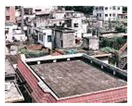 | Green Roofs with Ivy |  |
| Building Facades | Ceramic Tiles + Brick Walls |  | Green Facades |  |
| Simulation Settings |
|---|
| Simulation Input Data |
| Geographic Location (Latitude, Longitude): 22.5, 114.10 |
| Reference time zone: GMT + 8 |
| Simulation Model Size (m): 162 m (L) × 162 m (W) × 88 m (H) |
| Simulation Model Area (Number of Grids) xyz-Grids: 85 × 85 × 44 |
| Size of grid cell (meters) x, y, z: 2 × 2 × 2 |
| Method of vertical grid generation: Equidistant |
| Main Model Parameters |
| Simulation Model Date: 9 August 19 |
| Start and Duration of Simulation: 01:00, 24 h |
| Initial Wind Speed: 3.3 m/s |
| Wind Direction: 184° |
| Initial Temperature: 28 °C |
| Initial Relative Humidity (%): 77.23% |
| Model Materials and Properties |
| Building Materials |
| Original Model: [0100B2] BRICK WALL (Burned): 0.24 m (Substrate Thickness) |
| Designed Model: [0100IV] Ivy (Hedera helix): 0.12 m (Plant Thickness), 0.24 m (Substrate Thickness) |
| Pavements |
| Original Model: [0100ST] Asphalt Rd, [0100PP] Pavement (Concrete), used/dirty |
| Designed Model: [0100KK] Brick Road (Red stones) |
| Albero |
| Designed Model: [020031] Bluebell Tree (middle) |
| 3D Plant Species | Simulation Trees Scenarios | Values |
|---|---|---|
| Bluebell (middle) |  | Height (m): 18.42 |
| Width (m): 10.64 × 10.66 | ||
| LAD (August): 1.00 | ||
| Number of trees: 12 |
| PET(°C) | Thermal Sensation | Physiological Stress Level |
|---|---|---|
| <4 | very cold | extreme cold stress |
| 4–8 | cold | strong cold stress |
| 8–13 | cool | moderate cold stress |
| 13–18 | slightly cool | slight cold stress |
| 18–23 | comfortable | no thermal stress |
| 23–29 | slightly warm | slight heat stress |
| 29–35 | warm | moderate heat stress |
| 35–41 | hot | strong heat stress |
| >41 | very hot | extreme heat stress |
Disclaimer/Publisher’s Note: The statements, opinions and data contained in all publications are solely those of the individual author(s) and contributor(s) and not of MDPI and/or the editor(s). MDPI and/or the editor(s) disclaim responsibility for any injury to people or property resulting from any ideas, methods, instructions or products referred to in the content. |
© 2023 by the authors. Licensee MDPI, Basel, Switzerland. This article is an open access article distributed under the terms and conditions of the Creative Commons Attribution (CC BY) license (https://creativecommons.org/licenses/by/4.0/).
Share and Cite
Zheng, Y.; Keeffe, G.; Mariotti, J. Nature-Based Solutions for Cooling in High-Density Neighbourhoods in Shenzhen: A Case Study of Baishizhou. Sustainability 2023, 15, 5509. https://doi.org/10.3390/su15065509
Zheng Y, Keeffe G, Mariotti J. Nature-Based Solutions for Cooling in High-Density Neighbourhoods in Shenzhen: A Case Study of Baishizhou. Sustainability. 2023; 15(6):5509. https://doi.org/10.3390/su15065509
Chicago/Turabian StyleZheng, Ying, Greg Keeffe, and Jasna Mariotti. 2023. "Nature-Based Solutions for Cooling in High-Density Neighbourhoods in Shenzhen: A Case Study of Baishizhou" Sustainability 15, no. 6: 5509. https://doi.org/10.3390/su15065509
APA StyleZheng, Y., Keeffe, G., & Mariotti, J. (2023). Nature-Based Solutions for Cooling in High-Density Neighbourhoods in Shenzhen: A Case Study of Baishizhou. Sustainability, 15(6), 5509. https://doi.org/10.3390/su15065509







